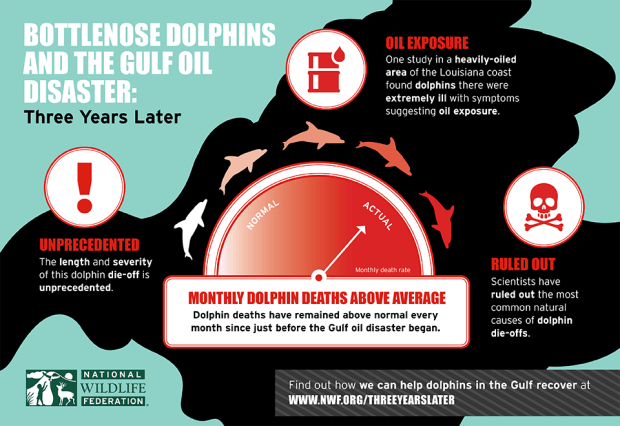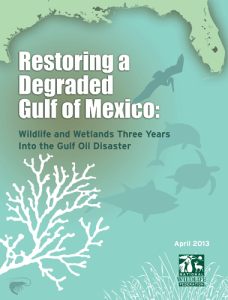We have much more to do and your continued support is needed now more than ever.
Dolphin Deaths in the Gulf Three Years After Oil Spill
In August 2011, scientists did a comprehensive examination of a 16-year-old male bottlenose dolphin. This dolphin — dubbed Y12 for research purposes — was found near Grand Isle, a Louisiana barrier island that was hit hard during the Gulf oil disaster.
Like many of the 31 other dolphins examined in a recent study, Y12 was found to be severely ill: underweight, anemic and with signs of liver and lung disease. The dolphins’ symptoms were consistent with those seen in other mammals exposed to oil; researchers feared many of the dolphins studied were so ill they would not survive.
Seven months later, Y12’s emaciated carcass washed up on the beach at Grand Isle.
More than 650 dolphins have been found stranded in the oil spill area since the Gulf oil disaster began. This is more than four times the historical average.

Read the Report
“Three years after the initial explosion, the impacts of the disaster continue to unfold,” said Doug Inkley, senior scientist for the National Wildlife Federation and lead report author. “Dolphins are still dying in high numbers in the areas affected by oil. These ongoing deaths — particularly in an apex predator like the dolphin — are a strong indication that there is something amiss with the Gulf ecosystem.”
 Restoring a Degraded Gulf of Mexico: Wildlife and Wetlands Three Years into the Gulf Oil Disaster looks at how different species of wildlife across the northern Gulf are faring in the wake of the oil disaster.
Restoring a Degraded Gulf of Mexico: Wildlife and Wetlands Three Years into the Gulf Oil Disaster looks at how different species of wildlife across the northern Gulf are faring in the wake of the oil disaster.
- The National Oceanic and Atmospheric Administration (NOAA) called the dolphin die-off “unprecedented” a year ago.
- More than 1,700 sea turtles were found stranded between May 2010 and November 2012 — the last date for which information is available. For comparison, on average about 240 sea turtles are stranded annually.
- A coral colony seven miles from the wellhead was badly damaged by oil. A recent laboratory study found that a mixture of oil and dispersant affected the ability of some coral species to build new parts of a reef.
- Scientists found that the oil disaster affected the cellular function of the killifish, a common baitfish at the base of the food web. A recent laboratory study found that oil exposure can also harm the development of larger fish such as mahi mahi.
“Despite the public reations blitz by BP, this spill is not over,” said David Muth, Director of the National Wildlife Federation’s Mississippi River Delta Restoration Program. “In 2012 six million pounds of tar mat and contaminated material from the BP spill were cleaned up from Louisiana’s coast. Justice will only be served when BP and its co-defendants pay to restore the wildlife and habitats of the Mississippi River Delta and the Gulf of Mexico.”
Two Ways to Help
![]() The high number of dolphin deaths is concerning, and wildlife across the Gulf continue to feel the effects of BP’s massive oil spill three years later. Residents of the Gulf and its wildlife need full restoration! Tell the Dept. of Justice to hold BP fully accountable for its actions>>
The high number of dolphin deaths is concerning, and wildlife across the Gulf continue to feel the effects of BP’s massive oil spill three years later. Residents of the Gulf and its wildlife need full restoration! Tell the Dept. of Justice to hold BP fully accountable for its actions>>
![]() You can also help NWF protect wildlife, like bottlenose dolphins in the Gulf, by donating today.
You can also help NWF protect wildlife, like bottlenose dolphins in the Gulf, by donating today.





















